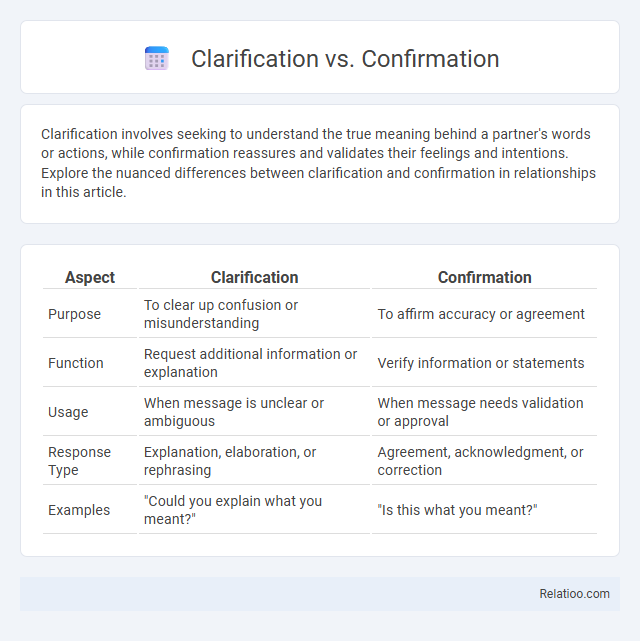Clarification involves seeking to understand the true meaning behind a partner's words or actions, while confirmation reassures and validates their feelings and intentions. Explore the nuanced differences between clarification and confirmation in relationships in this article.
Table of Comparison
| Aspect | Clarification | Confirmation |
|---|---|---|
| Purpose | To clear up confusion or misunderstanding | To affirm accuracy or agreement |
| Function | Request additional information or explanation | Verify information or statements |
| Usage | When message is unclear or ambiguous | When message needs validation or approval |
| Response Type | Explanation, elaboration, or rephrasing | Agreement, acknowledgment, or correction |
| Examples | "Could you explain what you meant?" | "Is this what you meant?" |
Understanding Clarification and Confirmation
Understanding clarification involves seeking additional information to eliminate confusion and ensure accurate interpretation of communication. Confirmation entails verifying the accuracy of information or decisions by repeating or acknowledging details to prevent misunderstandings. Both clarification and confirmation enhance effective communication by fostering mutual understanding and reducing errors.
Key Definitions: Clarification vs Confirmation
Clarification involves providing additional information or explanation to remove ambiguity and ensure understanding, while confirmation is the process of verifying or affirming the accuracy or truth of information. Clarification seeks to enhance comprehension by addressing uncertainties, whereas confirmation validates the correctness or acceptance of facts or decisions. Both are essential in communication, with clarification focusing on message clarity and confirmation ensuring agreement or accuracy.
The Importance of Clarification in Communication
Clarification in communication ensures that messages are understood accurately by resolving ambiguities and preventing misunderstandings, which is critical for effective interaction. Confirmation verifies that the received message matches the sender's intent, often through feedback or restatement, reinforcing mutual understanding. Repeated clarification enhances clarity, reduces errors, and fosters trust, making it indispensable in professional and personal communication contexts.
Why Confirmation Matters in Conversations
Confirmation ensures your message is understood as intended, preventing miscommunication that can lead to errors or conflicts. Clarification seeks to clear up any confusion by providing additional information or restating points more clearly. You benefit from confirmation in conversations because it establishes shared understanding and trust, making interactions more effective and efficient.
Common Scenarios Requiring Clarification
Common scenarios requiring clarification often arise in professional communication, customer service, and legal discussions where ambiguous or incomplete information can lead to misunderstandings. Clarification seeks to resolve confusion by asking specific questions or rephrasing statements to ensure accurate comprehension. Unlike confirmation, which verifies previously understood information, clarification aims to uncover missing details or correct inaccuracies before proceeding.
When to Seek Confirmation in Discussions
Seek confirmation in discussions when the information shared impacts decisions, ensuring mutual understanding and preventing misinterpretations. Confirmation is crucial after key points or agreements, verifying accuracy and agreement between parties involved. Unlike clarification, which aims to clear up ambiguity, confirmation solidifies agreement and validates comprehension of facts or instructions.
Techniques for Effective Clarification
Techniques for effective clarification involve active listening, asking open-ended questions, and paraphrasing to ensure accurate understanding of your message. Confirming details by summarizing key points helps to eliminate confusion and reinforces clear communication. Using concise language and non-verbal cues further supports precise clarification and enhances overall interaction quality.
Best Practice Methods for Confirmation
Best practice methods for confirmation emphasize clear, concise verification through active listening and restating information to ensure mutual understanding between parties. Techniques such as summarizing key points, using closed-ended questions, and obtaining explicit verbal or written acknowledgment help prevent miscommunication and establish accountability. Implementing standardized confirmation protocols in professional and customer interactions enhances accuracy, trust, and efficiency in information exchange.
Clarification vs Confirmation: Avoiding Miscommunication
Clarification involves seeking additional information to ensure accurate understanding, while confirmation means verifying that the received message matches the intended meaning. You prevent miscommunication by actively clarifying ambiguous points and confirming key details in conversations or instructions. Effective communication relies on balancing these processes to reduce errors and enhance mutual comprehension.
Enhancing Communication Skills with Clarification and Confirmation
Enhancing communication skills with clarification involves actively seeking to understand the speaker's message by asking questions or restating information to avoid misunderstandings. Confirmation strengthens communication by verifying that the received message matches the sender's intent through feedback techniques such as paraphrasing or summarizing. Combining clarification and confirmation processes reduces errors and improves mutual understanding in both personal and professional interactions.

Infographic: Clarification vs Confirmation
 relatioo.com
relatioo.com